This article is not about the Best Mid cap funds to Invest in and then take you to fund performances, Fund Management, pros and cons etc. All these details are easily available nowadays online on various websites, which all “DIY” Investors can access.
And for those who already has advisors with them they can always ask such questions to the professionals.
But As I always say the Asking Right Questions are very important to get the Right Answers. And when you have Right questions with you, you will also know whom to ask this to? Read more: Financial Advisor in India – The Best for your Financial Planning?
So, when I say, which Mid Cap fund is the Best, I meant, with the so many variants of mid-caps now in the market, which would be better to look at and invest without cluttering the portfolio and suitable to the goal-based investments
Mid Cap funds are no longer a simple category. Earlier there used to be only one Active Fund with all the fund houses, then came out the passive category and Midcap 150 Index fund came up as a low-cost flavour.
Later, there came variation in index-based funds and Midcap 50 and Midcap 100 came into the picture. And now to make things more complicated, the search for Alpha has led to coming up of more variety in the form of smart beta Index funds and thus the announcement of Midcap 150 Quality 50, and now the latest one Momentum 50 strategies.
These funds claim to provide high benchmark beating returns at lower cost then Active management. Of Course, Investment Returns is the only Pitch which investors like. Read more: Index funds in India – How attractive is Passive Investing?
Let’s have a look at all these funds one by one.
Nifty Midcap 150
Midcap 150 index is the broad index of all the Mid-caps. This is the base index from where all other smart betas emerge and even Active Managers use this index for their stock selection.
Midcap 150 is designed basis the Market capitalisation. Every Mid cap fund’s target is to beat return of this index only.
NIFTY Midcap 150 represents the 150 companies (companies ranked 101-250) based on full market capitalisation from NIFTY 500. This index intends to measure the performance of mid-market capitalisation companies.
Nifty Midcap 50
It includes top 50 companies based on full market capitalisation from Nifty Midcap 150 index. A preference is given to companies that are available for trading in NSE’s Futures & Options segment at the time of final selection.
On the face of it, this sounds that out of 150 mid cap companies, these are top 50 or may be the “Best 50 among 150”, which actually is not right. It could be Top 50 in market cap but may not be the BEST
These are the companies whose market capitalisation are higher than the other 100 in this category.
Nifty Mid Cap 100
It includes all companies from Nifty Midcap 50. Remaining companies are selected based on average daily turnover from Nifty Midcap 150 index. Or you may say these are the first 100 companies in Nifty Midcap 150 Index.
Best Midcap funds – Returns comparison of Midcap 150, Midcap 50 and Midcap 100
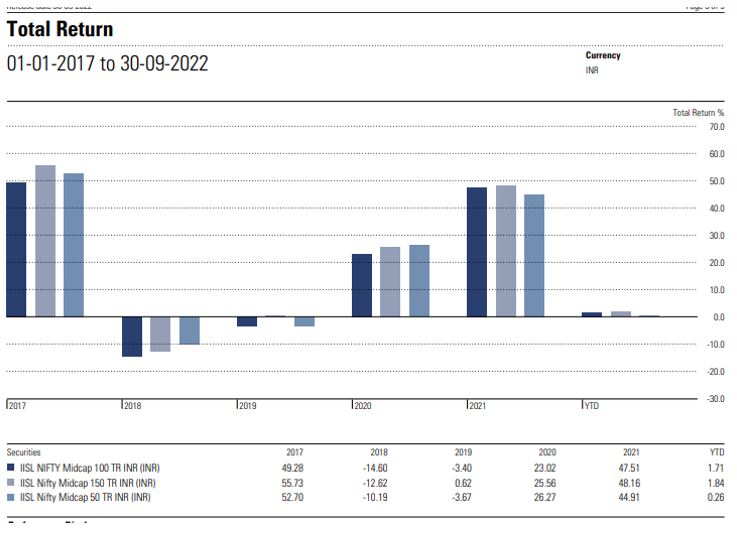
Last 5 years Total Return (which means the valuation gain plus dividends), gives a fair idea as to how Midcap 150 has been a better performer than the other 2 indices, which may be considered as the better ones.
However, these are calendar year returns, which may not show the actual investor returns.
Below chart shows the point-to-point return since inception of all these funds.
Investment growth of Rs 10000 since 2005
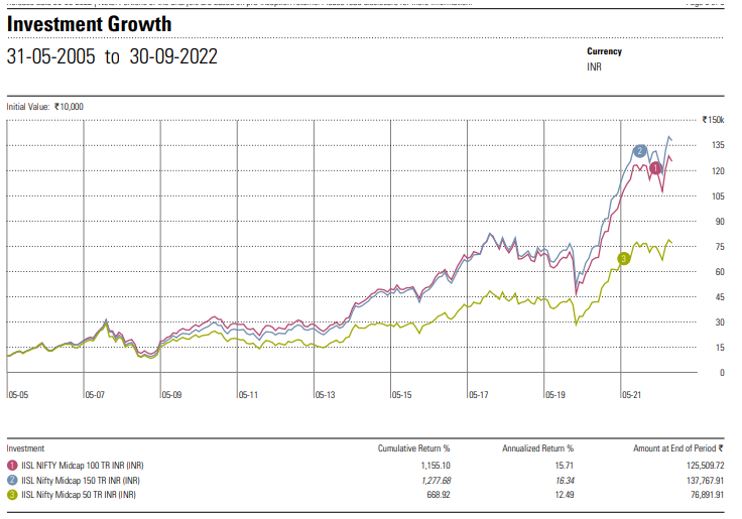
Though I have never seen any investor stay invested in funds for so long, but still this is how your money would have multiplied in all these years.
These kinds of funds were not available in 2005, but back testing data is available now. Last 20 years always encourage to invest for next 20 years, but returns never show the volatility during that period. And numbers also does not let you feel the actual pain of volatility.

It is what one has to experience in real time and which is where one loses the patience and surrender to fear and emotional biases.
The above 3 are the broad-based indices which came out of the Market capitalisation and Free Float Market Index.
Now the search of Alpha has led to coming up with Strategy indices, where the formulas were applied to broad indices to take out Quality and Momentum stocks and indices and in turn the funds/ETFs Read more: Should you Buy Gold Jewellery or Gold ETF?
Nifty Midcap 150 Quality 50
The Nifty Midcap150 Quality 50 index includes top 50 companies from its parent Nifty Midcap 150 index, selected based on their ‘quality’ scores.
The quality score for each company is determined based on return on equity, financial leverage (except for financial services companies) and earning per share (EPS) growth variability of each stock analysed during the previous 5 financial years. (Read: Smart Beta Index funds)
The weight of each stock in the index is based on a combination of stock’s quality score and its free float market capitalization.
Below is the Point-to-Point return comparison of last 10 years of Quality 50 with the broad index i.e. Mid cap 150
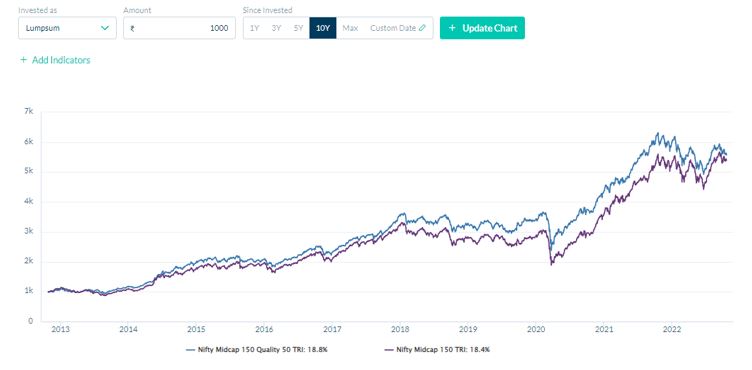
Like as I said above, Trailing point to Point return may not show the actual investor return so let’s have a look at the 5 year Rolling return of these 2 segments
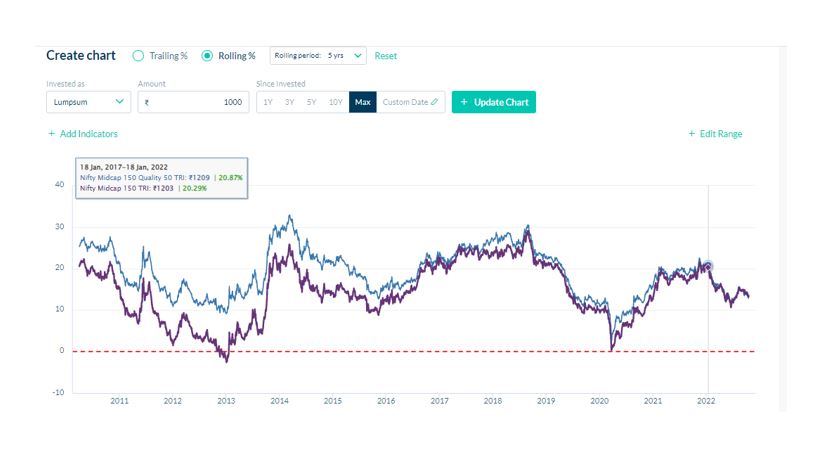
5 year rolling returns since 2005, shows quality has actually done well. Even in the struggling times it has generated better or equal to Midcap 150 TRI. But the return gap has considerably reduced over a period of time. Of Course with the flow of information, easy availability of data and when more and more players enter into the market the scope of Alpha gets minimized. Also read more: Rolling Returns- A better tool to evaluate Mutual funds
Nifty Midcap 150 Momentum 50
Nifty Midcap150 Momentum 50 Index aims to track the performance of the top 50 companies within the Nifty Midcap 150 selected based on their Normalized Momentum Score.
The Normalized Momentum Score for each company is determined based on its 6month and 12-month price return, adjusted for volatility.
Stock weights are based on a combination of the stock’s Normalized Momentum Score and its free-float market capitalization.
Sounds complicated, right?
In simple terms Momentum investing is about, investing in the stocks that are growing and high on demand in specific time. Momentum investing is a strategy that aims to capitalize on the continuance of existing trends in the market.
Momentum Investing does not look at Fundamentals like quality, neither it gets into valuation…it all looks at Price and Volatility of the stocks.
In Midcap, Tata Mutual fund has recently closed their NFO, and will reopen soon, and I am sure many more will be coming in near future.
Returns comparison of Momentum 50 with broad index Mid Cap 150

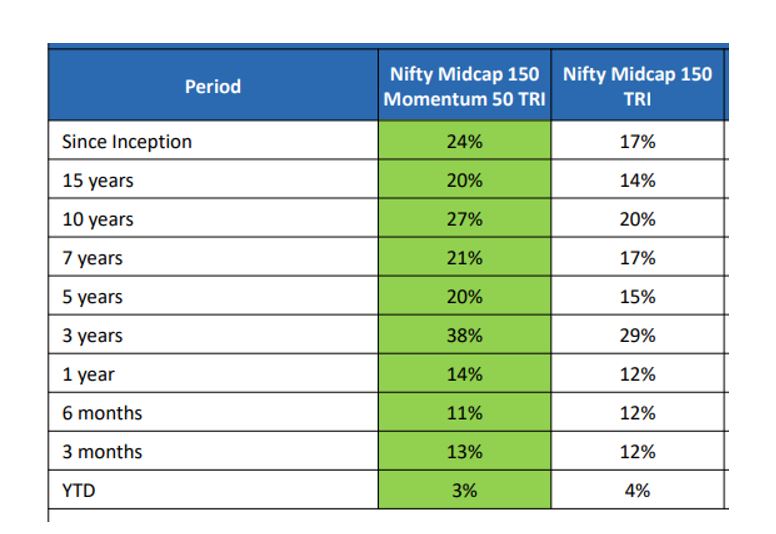
How to select Best Midcap funds in India?
Now, lets come back to the main question again.
See, though returns always attract but Risk and volatility is something which is not easily acceptable to all. So first and foremost, you need to understand that Midcaps itself is highly risky segment. So, enter with a caution.
But for very long-term investor, this segment can be highly paying too. So, one should not avoid this completely. But have an Asset Allocation at place.
The second aspect one needs to understand that Diversification can help in curtailing Risk.
So, Midcaps with diversification may help you manage the risk with not much compromising on the return side. Midcap 150 is the most diversified among all. It’s the broad index which every Midcap funds follow and tries to beat…why not buy it directly. Read More: Types of Risks in investments and how to manage them
Other funds have concentrated portfolio which may look good in booming markets but in bear markets they may be the laggards. And as I wrote above, accepting volatility for returns needs patience and discipline.
You need to be prepared to experience long Lull period to actually gain out of your investments. Longer the investment time frame all things get averaged out.
Active Investments does look at all these factors in totality along with fundamental and then pick the stocks, so you may consider a diversified active fund too.
Hope you like this article on Best Midcap funds. Do ask your questions in the Comments section below.







 Manikaran Singal is the founder and Chief financial planner at Good Moneying Financial Solutions. He is a CERTIFIED FINANCIAL PLANNER CM and SEBI registered Investment adviser (Regd no. INA 100001620). He’s having 20+ years of experience in financial services space.
Manikaran Singal is the founder and Chief financial planner at Good Moneying Financial Solutions. He is a CERTIFIED FINANCIAL PLANNER CM and SEBI registered Investment adviser (Regd no. INA 100001620). He’s having 20+ years of experience in financial services space.

